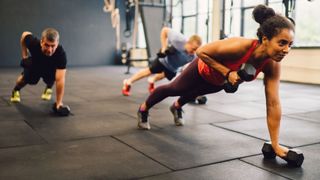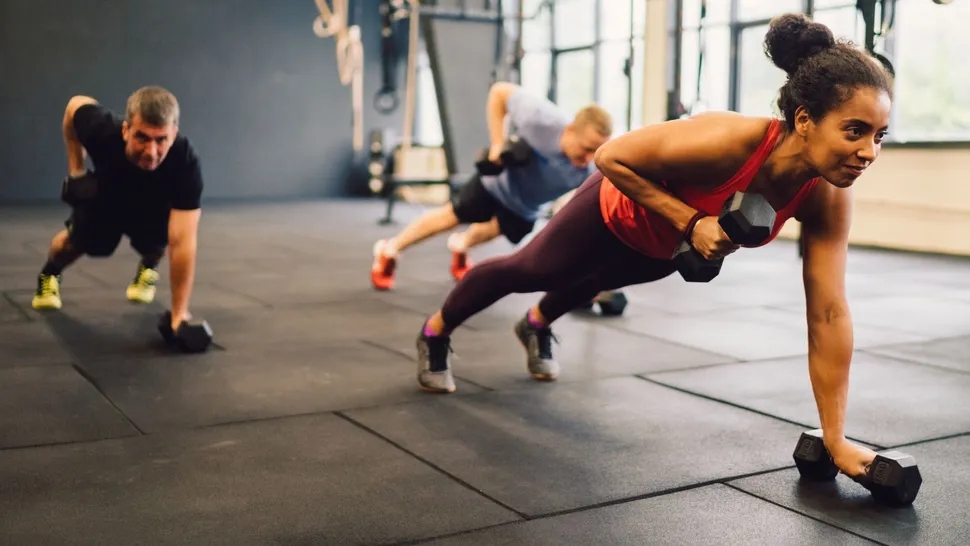How do muscle cells grow after a workout? And how do your genetics affect your experience as a gymgoer.

Resistance exercises, like weightlifting, push muscle cells to make new proteins and thus fuel muscle growth. (Image credit: martin-dm via Getty Images)
If you’re looking to gain muscle mass, a quick web search will tell you to “bulk” on a high-calorie, high-protein diet, progressively challenge yourself with heavier weights and rest in between workouts. But have you ever wondered how these measures actually boost the size of your guns? Whether you’re a novice gymgoer or an experienced bodybuilder, learning the biology of skeletal muscle growth can help you understand the process at the cellular level.
Everyone can benefit from weight training, even if getting ripped isn’t your end goal. You lose muscle mass with age, and it becomes exceedingly difficult to reverse course the frailer you become, Kevin Murach, who researches muscle growth at the University of Arkansas, told Live Science.
Growth occurs when cells in the muscle make, or synthesize, new proteins faster than existing proteins are broken down. Tension from weightlifting and other exercises in which you lift or pull against resistance triggers synthesis. Muscle damage that occurs during exercise and leads to soreness can also trigger growth, lending credence to the phrase “no pain, no gain.”
But if you’re not used to working out or if you complete high-intensity training, muscles can incur too much damage and a significant amount of synthesis will be used to repair broken muscle fibers and to clear away inflammation during rest rather than to pump up muscles, Murach explained. Focusing on concentric contractions, in which the muscle shortens as resistance is applied, more so than eccentric ones, in which the muscle lengthens, can maximize tension and minimize damage, he suggested.
Within individual muscle fibers, some proteins, like the mammalian target of rapamycin (mTOR), are activated by tension and support growth by promoting muscle protein synthesis. Other proteins, like myostatin, keep muscle growth in check.
Some animals genetically suppress myostatin and thus maximize their gains, including some incredibly buff racing dogs called “bully” whippets. “The breaks are taken off of muscle growth, so the muscle becomes very large,” Murach said. In people, regular resistance training lowers the amount of myostatin secreted by muscle cells over time, he added, which could lead to faster gains.
Muscle fibers are tubular muscle cells. Unlike other body cell types, they contain multiple nuclei, none of which can divide. Although protein synthesis can boost muscle mass, these non-dividing nuclei limit the potential for muscle growth. Muscle stem cells called satellite cells compensate for this by donating their nuclei into growing muscle fibers. You lose satellite cells as you age, which could be one reason why it’s harder to recover muscle mass in your later years. But this loss can be partially offset by exercise, which causes satellite cells to proliferate. CLOSE
How do genetics affect muscle growth?
Have you ever wondered why some people struggle to see results, even if they bulk on protein and pump iron to their limits? Muscle growth is controlled by genetic factors, as well.
Everyone has a variable mixture of two muscle fiber types that are specialized for different exercises. Fast-twitch fibers are geared toward powerful, explosive movements, whereas slow-twitch fibers support sustained, endurance exercises and joint stabilization. Fast-twitch fibers grow more readily than slow-twitch ones, so people who struggle to put on muscle mass may have a smaller proportion of these.
Although the ratio is largely genetically predetermined, Murach said “it can shift — you’re not stuck with what you have.” Focusing on weightlifting over endurance training could make fast-twitch fibers dominant, but these changes are localized to the muscles you train, he explained.
Sex differences can also affect muscle growth. The “male” hormone testosterone boosts protein synthesis and activates satellite cells. The higher levels of testosterone that members of the male sex experience during puberty could explain why males typically have more muscle mass than females at baseline. But when adults are put on the same weightlifting programs, their gains relative to their size tend to be equivalent between the sexes, Murach said, because the transient bursts of testosterone that occur with exercise don’t contribute massively to growth.
Ribosomes — the molecular machines that synthesize proteins — have recently been identified as another potential genetic factor behind muscle gains. Due to genetic differences, people possess different types and quantities of ribosomes, which could affect levels of protein synthesis and the types of muscle proteins produced.
These genetic factors can unfairly burden some gymgoers, making it more difficult to put on muscle mass. The encouraging news is that several lines of evidence — including that you can lower myostatin, proliferate satellite cells and tune your muscle fiber ratio — suggest everyone’s muscles can be adapted to grow.


